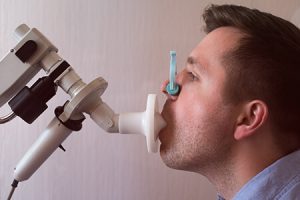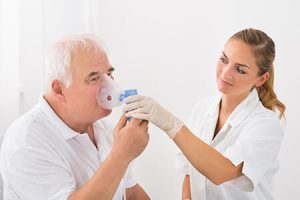Chronic Obstructive Pulmonology Disease
COPD, its causes, symptoms, diagnosis and treatment
Things you need to know about COPD
What is chronic obstructive pulmonary disease?
Chronic obstructive pulmonary disease (COPD) is a chronic inflammatory lung disease, which causes obstruction of airflow to the lungs. Chronic obstructive pulmonary disease enhances risk of developing heart diseases, lung cancer and a number of other conditions.
Chronic obstructive pulmonary disease is preventable and treatable. Most patients with COPD can experience good symptom control and quality of life with proper medical treatment and lifestyle modification.
What are the causes of COPD?
The two most common conditions that contribute to COPD are: Chronic bronchitis, and Emphysema.
The most common causes of COPD include:
- Cigarette, tobacco smoke and other irritants: Long-term cigarette smoking causes damage to lungs that contributes to COPD. Other irritants are cigar smoke, pipe smoke, passive smoking, air pollution and workplace exposure to dust, smoke or fumes.
- Alpha-1-antitrypsin deficiency: Alpha-1-antitrypsin protein helps in protecting the lungs. Deficiency of alpha-1-antitrypsin caused by a genetic disorder is associated with the development of COPD.

Causes of Chronic Obstructive Pulmonology Diseases
What are the symptoms of COPD?
Symptoms of COPD typically don’t appear until the lung damage has worsened. Some common symptoms of COPD are:
- A chronic (long standing) cough
- Chest tightness
- Cyanosis (bluish discolouration of the nailbeds or lips)
- Frequent respiratory infections
- Lack of energy
- Production of excess mucus
- Shortness of breath (especially during physical activities)
- Swelling in ankles, feet or legs
- Unintended weight loss
- Wheezing (whistle like sound on exhaling)
What are the risk factors of COPD?
Some of the common conditions that increase the susceptibility of acquiring the disease or the risk factors for COPD include:
- Advancing age
- Heredity i.e. from one generation to another
- Long term active or passive exposure to tobacco smoke, more so if you have asthma
- Long term exposure to fumes from burning fuel
- Occupational exposure to dusts and chemicals
What are the complications of COPD?
Chronic obstructive pulmonary disease can cause many complications, including:
- Depression
- High blood pressure in lung arteries
- Increased risk of respiratory infections
- Lung cancer
- Risk of heart diseases
How is COPD diagnosed?
If your cough doesn’t subside with routine medications and you have a history of smoking or other risk factors of COPD, consult a Pulmonologist or physician. COPD can be diagnosed by:
- Medical history
- Physical examination
- Tests as required
- Pulmonology function tests: To measure the amount of air being inhaled and exhaled. To check weather lungs can deliver enough oxygen to blood.
- Chest X-ray. To check emphysema. To rule out other lung problems or heart failure.
- Computed tomography scan: To detect emphysema. It can also be used to screen for lung cancer.
- Arterial blood gas analysis: To determine the concentration of gases like oxygen and carbon dioxide in the blood.
- Laboratory tests: To determine alpha-1-antitrypsin deficiency.

Diagnosis of Chronic Obstructive Pulmonology Disease – COPD
How is COPD treated?
Effective therapeutic management of COPD can offer symptomatic relief, lower risk of complications and exacerbations, and improve quality of life.
- Smoking cessation: The most important step in the management of COPD is smoking cessation. It’s necessary to prevent COPD from getting worse.
- Medications: Several medications are used to treat the symptoms and complications of COPD.
- Lung therapies: Additional lung therapies are administered in moderate or severe COPD.
- Oxygen therapy
- Pulmonology rehabilitation program
- Surgery: Helpful to some patients with severe emphysema who cannot achieve symptomatic relief with medications alone. Surgical options include:
- – Lung volume reduction surgery
- – Lung transplant
- – Bullectomy
What type of diet and lifestyle modification should be followed in COPD?
In COPD, following modifications in lifestyle can slow lung damage and provide relief:
- Control breathing: Learn techniques for breathing more efficiently throughout the day. Also, learn about breathing positions and relaxation techniques that can be useful during shortness of breath.
- Clear airways:Controlled coughing, consumption of plenty of water and using a humidifier may help in clearing mucus filled air passage.
- Exercise regularly:Regular exercise may improve overall strength and endurance.
- Eat healthy foods:A healthy diet may help in strength maintenance.
- Avoid smoke and air pollution:Avoid places where air pollution is higher.
- See your doctor regularly: Along with treatment adherence, regular checkup at hospital is important.

COPD – Diet and lifestyle to be modified
To know more about COPD and its management, you can request for a call back and our COPD specialist will call you and answer all your queries.
Related blogs you may like to read:
References
- Mayo Clinic. Chronic obstructive pulmonary disease. Available at:https://www.mayoclinic.org/diseases-conditions/copd/symptoms-causes/syc-20353679. Accessed on: 10 March 2018.
- American Thoracic Society. Chronic obstructive pulmonary disease. Available at: http://www.thoracic.org/patients/patient-resources/resources/copd-intro.pdf. Accessed on: 10 March 2018.
- American Lung Association. Chronic obstructive pulmonary disease. Available at: http://www.lung.org/lung-health-and-diseases/lung-disease-lookup/copd/. Accessed on: 10 March 2018.
Disclaimer:
“The content of this publication has been developed by a third party content providerwho are clinicians and/or medical writers and/or experts. The information contained herein is for educational purpose only and we request you to please consult a Registered Medical Practitioner or Doctor before deciding the appropriate diagnosis and treatment plan.”



 Appointment
Appointment Second Opinion
Second Opinion WhatsApp
WhatsApp Call
Call More
More





